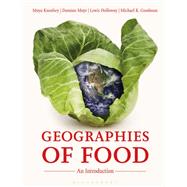Food is pivotal to the human experience. Its production and preparation occupies the waking hours of millions of people, and structures the domestic spaces and routines of everyday life. Around the world, from local community groups to inter-governmental summits, people are discussing the future of food in the face of threats from climate change, population growth and natural resource depletion.
This textbook provides a comprehensive introduction to the contemporary geographies of food. It begins by exploring the relationship between food, place and space and then examines the contemporary food 'crisis' in all its dimensions, as well as the many solutions which are currently being proposed.
Drawing on international case studies, this text examines the complex relationships operating between people and processes at a range of geographical scales, from the shopping decisions of a mother in a British supermarket, to the crop choices made by a farmer in West Africa; from high-level political negotiations at the World Trade Organization, to the strategies of giant agri-businesses whose activities span several continents.
Including a range of lively pedagogical features and case studies, this textbook is accompanied by a companion website with additional teaching and learning resources.








